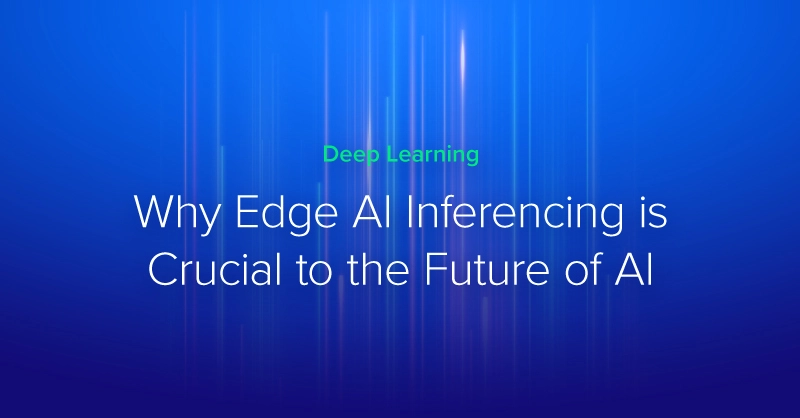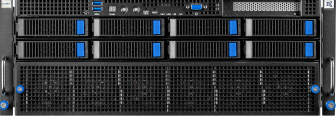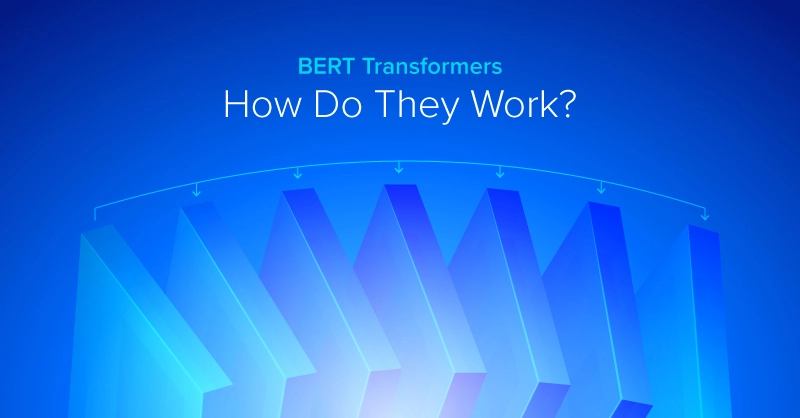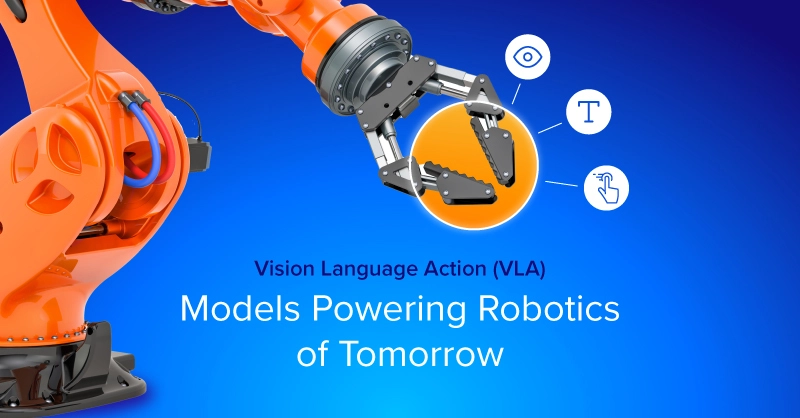
Introduction
The convergence of edge computing and artificial intelligence (AI) inferencing is rapidly reshaping the landscape of modern computing. The computing focus has largely been on the data center, with AI training being the focus of most companies. Engineers must deploy AI models for inference to reach end users.
AI in the real world with real-time response is the goal. For chatbots and generative AI agents, minor latency is acceptable and doesn't hurt the experience. However, future AI applications will require near-instantaneous responses and actions like robotics in factories and autonomous cars. This is the promise of edge AI, where the computations run closer to or even at the data source for real-time response and action.
What is Edge Computing & What is AI Inferencing
Edge Computing is where hardware is deployed closer to the data source for immediate data analysis. Local servers and devices at the "edge" process data instead of relying on the cloud or the data center.
- Decentralized processing reduces latency, allowing for faster response times in critical applications. IoT devices process information without passing it back to the data center.
- Real-time data enables immediate analysis, insights, and actions based on local data streams.
AI Inferencing is deploying trained AI-powered models to process new data for making analysis, predictions, decisions, or a combination of all three. In Edge AI Inferencing, AI models are loaded directly to devices to process data locally for inferencing tasks. Edge AI enables intelligent and autonomous operations with lower latency than inferencing from the cloud or data center.
- Deploying AI models to the edge allows for localized decision-making without constant cloud connectivity.
- Localized decision-making enhances privacy, reduces bandwidth consumption, and ensures reliable performance even in disconnected environments.

Fueling Innovation with an Exxact Multi-GPU Server
Training AI models on massive datasets can be accelerated exponentially with the right system. It's not just a high-performance computer, but a tool to propel and accelerate your research.
Configure NowAddressing the Challenges of Edge AI Inferencing
Despite its immense potential, implementing edge AI presents significant technical challenges.
- Resource constraints: Edge devices often have power, memory, and sometimes battery constraints limiting performance.
- Security concerns: Distributed edge devices create new security vulnerabilities when running AI models on them.
- Connectivity issues: Edge environments are susceptible to unreliable network connectivity, requiring robust solutions for running AI models locally.
The challenges of Edge AI necessitate solutions, like model compression techniques, specialized hardware accelerators, and robust security protocols. For the past 5 years, NVIDIA has pushed Collaboration between hardware vendors, software developers, and AI researchers is essential to unlock the full potential of edge AI.
Successfully deploying AI inferencing at the edge requires a strategic approach to address the inherent limitations of edge environments. Several key strategies can help overcome the edge AI bottleneck and unlock its potential:
Model Compression
Reducing the size and complexity of AI models is crucial for efficient deployment on resource-constrained edge devices.
- Quantization can help trim the computational precision (e.g., from FP32 to INT8), reducing model size and computational demand. NVIDIA has continued to introduce low and lower precision floating point formats like FP8 and FP4. With mixed precision, tasks that don’t require extreme precision, like LLMs, can still have amazing results.
- Pruning can help by removing redundant and less important connections in the model to reduce the number of parameters. Reducing connections and parameters results in fewer computations and better performance. Pruning could have an unintentional effect on neural network performance.
- Distillation or ****distilled models deployed at the edge can promote efficiency and less powerful hardware requirements. Distillation is training a smaller model to mimic the behavior of the larger foundational model.
Hardware Acceleration
Utilizing specialized hardware accelerators can dramatically improve the performance of AI inferencing on edge devices. NVIDIA has developed robotics processors like Jetson and Thor for specialized robotics and autonomous car inference tasks.
- Dedicated GPUs and Integrated GPUs: Parallel processing capabilities are well-suited for various AI computations. Perception algorithms and quick decision-making require immense computational resources.
- FPGAs (Field-Programmable Gate Arrays): FPGAs are a customizable accelerator for implementing dedicated AI inferencing engines tailored to specific model architectures. Engineers program FPGAs for specific tasks, useful in unique computing environments.
Future hardware innovations continue to prioritize performance per watt to enable efficient edge computing.
Federated Learning
Federated learning enables collaborative AI model training while preserving data security. This approach maintains privacy by training models across multiple edge devices and aggregating results without sharing the raw data.
- Decentralized Training: Each edge device handles data processing and trains its model locally.
- Model Aggregation: Trained model parameters are aggregated periodically and shared to update and improve the foundational model.
- Privacy Preservation: Data stays on local edge devices, reducing security risks and data breaches of sensitive information.
Implemented effectively, these strategies significantly enhance edge AI deployments' performance, efficiency, and security, laying the foundation for widespread industry adoption.
Edge AI within the Broader AI Landscape
Edge AI is not meant to replace cloud-based and data center AI computing infrastructures. Data centers and remote processing remain essential for aggregated training, data storage, and large-scale analytics. Edge AI focuses on deploying these trained models to edge devices for real-time inference.
- Data Centers for Training: Data centers provide the computing power needed to train AI models. They also help update edge models and periodically handle the more complex queries.
- Edge for Deployment: AI models are optimized and deployed to edge devices once they are trained. These edge devices handle rapid inferencing, where milliseconds of latency shouldn’t be spared.
Edge AI computing will define real-world AI and bring innovations to the real world.
At Exxact, we deliver computing solutions for any workload, such as training AI or bringing devices to the edge. As elite solutions integration partners with NVIDIA, AMD, Intel, and more, we configure and build custom computing solutions tailored to your use case. Talk to our engineers for more information on how we can conquer your challenges.
.png)
Fueling Innovation with an Exxact Multi-GPU Server
Training AI models on massive datasets can be accelerated exponentially with the right system. It's not just a high-performance computer, but a tool to propel and accelerate your research.
Configure Now
Why Edge AI Inferencing is Crucial to the Future of AI
Introduction
The convergence of edge computing and artificial intelligence (AI) inferencing is rapidly reshaping the landscape of modern computing. The computing focus has largely been on the data center, with AI training being the focus of most companies. Engineers must deploy AI models for inference to reach end users.
AI in the real world with real-time response is the goal. For chatbots and generative AI agents, minor latency is acceptable and doesn't hurt the experience. However, future AI applications will require near-instantaneous responses and actions like robotics in factories and autonomous cars. This is the promise of edge AI, where the computations run closer to or even at the data source for real-time response and action.
What is Edge Computing & What is AI Inferencing
Edge Computing is where hardware is deployed closer to the data source for immediate data analysis. Local servers and devices at the "edge" process data instead of relying on the cloud or the data center.
- Decentralized processing reduces latency, allowing for faster response times in critical applications. IoT devices process information without passing it back to the data center.
- Real-time data enables immediate analysis, insights, and actions based on local data streams.
AI Inferencing is deploying trained AI-powered models to process new data for making analysis, predictions, decisions, or a combination of all three. In Edge AI Inferencing, AI models are loaded directly to devices to process data locally for inferencing tasks. Edge AI enables intelligent and autonomous operations with lower latency than inferencing from the cloud or data center.
- Deploying AI models to the edge allows for localized decision-making without constant cloud connectivity.
- Localized decision-making enhances privacy, reduces bandwidth consumption, and ensures reliable performance even in disconnected environments.

Fueling Innovation with an Exxact Multi-GPU Server
Training AI models on massive datasets can be accelerated exponentially with the right system. It's not just a high-performance computer, but a tool to propel and accelerate your research.
Configure NowAddressing the Challenges of Edge AI Inferencing
Despite its immense potential, implementing edge AI presents significant technical challenges.
- Resource constraints: Edge devices often have power, memory, and sometimes battery constraints limiting performance.
- Security concerns: Distributed edge devices create new security vulnerabilities when running AI models on them.
- Connectivity issues: Edge environments are susceptible to unreliable network connectivity, requiring robust solutions for running AI models locally.
The challenges of Edge AI necessitate solutions, like model compression techniques, specialized hardware accelerators, and robust security protocols. For the past 5 years, NVIDIA has pushed Collaboration between hardware vendors, software developers, and AI researchers is essential to unlock the full potential of edge AI.
Successfully deploying AI inferencing at the edge requires a strategic approach to address the inherent limitations of edge environments. Several key strategies can help overcome the edge AI bottleneck and unlock its potential:
Model Compression
Reducing the size and complexity of AI models is crucial for efficient deployment on resource-constrained edge devices.
- Quantization can help trim the computational precision (e.g., from FP32 to INT8), reducing model size and computational demand. NVIDIA has continued to introduce low and lower precision floating point formats like FP8 and FP4. With mixed precision, tasks that don’t require extreme precision, like LLMs, can still have amazing results.
- Pruning can help by removing redundant and less important connections in the model to reduce the number of parameters. Reducing connections and parameters results in fewer computations and better performance. Pruning could have an unintentional effect on neural network performance.
- Distillation or ****distilled models deployed at the edge can promote efficiency and less powerful hardware requirements. Distillation is training a smaller model to mimic the behavior of the larger foundational model.
Hardware Acceleration
Utilizing specialized hardware accelerators can dramatically improve the performance of AI inferencing on edge devices. NVIDIA has developed robotics processors like Jetson and Thor for specialized robotics and autonomous car inference tasks.
- Dedicated GPUs and Integrated GPUs: Parallel processing capabilities are well-suited for various AI computations. Perception algorithms and quick decision-making require immense computational resources.
- FPGAs (Field-Programmable Gate Arrays): FPGAs are a customizable accelerator for implementing dedicated AI inferencing engines tailored to specific model architectures. Engineers program FPGAs for specific tasks, useful in unique computing environments.
Future hardware innovations continue to prioritize performance per watt to enable efficient edge computing.
Federated Learning
Federated learning enables collaborative AI model training while preserving data security. This approach maintains privacy by training models across multiple edge devices and aggregating results without sharing the raw data.
- Decentralized Training: Each edge device handles data processing and trains its model locally.
- Model Aggregation: Trained model parameters are aggregated periodically and shared to update and improve the foundational model.
- Privacy Preservation: Data stays on local edge devices, reducing security risks and data breaches of sensitive information.
Implemented effectively, these strategies significantly enhance edge AI deployments' performance, efficiency, and security, laying the foundation for widespread industry adoption.
Edge AI within the Broader AI Landscape
Edge AI is not meant to replace cloud-based and data center AI computing infrastructures. Data centers and remote processing remain essential for aggregated training, data storage, and large-scale analytics. Edge AI focuses on deploying these trained models to edge devices for real-time inference.
- Data Centers for Training: Data centers provide the computing power needed to train AI models. They also help update edge models and periodically handle the more complex queries.
- Edge for Deployment: AI models are optimized and deployed to edge devices once they are trained. These edge devices handle rapid inferencing, where milliseconds of latency shouldn’t be spared.
Edge AI computing will define real-world AI and bring innovations to the real world.
At Exxact, we deliver computing solutions for any workload, such as training AI or bringing devices to the edge. As elite solutions integration partners with NVIDIA, AMD, Intel, and more, we configure and build custom computing solutions tailored to your use case. Talk to our engineers for more information on how we can conquer your challenges.
.png)
Fueling Innovation with an Exxact Multi-GPU Server
Training AI models on massive datasets can be accelerated exponentially with the right system. It's not just a high-performance computer, but a tool to propel and accelerate your research.
Configure Now



.jpg?format=webp)